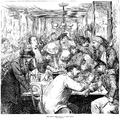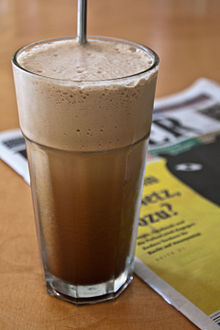The Coffee Portal
Coffee | Drinks | Coffeehouses | Companies | Culture | Preparation | Production
Introduction

Coffee is a beverage brewed from roasted coffee beans. Darkly colored, bitter, and slightly acidic, coffee has a stimulating effect on humans, primarily due to its caffeine content. It has the highest sales in the world market for hot drinks.
The seeds of the Coffea plant's fruits are separated to produce unroasted green coffee beans. The beans are roasted and then ground into fine particles typically steeped in hot water before being filtered out, producing a cup of coffee. It is usually served hot, although chilled or iced coffee is common. Coffee can be prepared and presented in a variety of ways (e.g., espresso, French press, caffè latte, or already-brewed canned coffee). Sugar, sugar substitutes, milk, and cream are often added to mask the bitter taste or enhance the flavor.
Though coffee is now a global commodity, it has a long history tied closely to food traditions around the Red Sea. The earliest credible evidence of coffee drinking as the modern beverage appears in modern-day Yemen in southern Arabia in the middle of the 15th century in Sufi shrines, where coffee seeds were first roasted and brewed in a manner similar to how it is now prepared for drinking. The coffee beans were procured by the Yemenis from the Ethiopian Highlands via coastal Somali intermediaries, and cultivated in Yemen. By the 16th century, the drink had reached the rest of the Middle East and North Africa, later spreading to Europe. (Full article...)
Selected article -

A coffee cup is a container, a cup, for serving coffee and coffee-based drinks. There are three major types: conventional cups used with saucers, mugs used without saucers, and disposable cups. Cups and mugs generally have a handle. Disposable paper cups used for take-out sometimes have fold-out handles, but are more often used with an insulating coffee cup sleeve.
Coffee cups and mugs may be made of glazed ceramic, porcelain, plastic, glass, insulated or uninsulated metal, and other materials. In the past, coffee cups have also been made of bone, clay, and wood. Disposable coffee cups may be made out of paper or polystyrene foam (often mistakenly called Styrofoam). (Full article...)General images -
More did you know? -
Selected drink -
A frappé coffee, cold coffee, Greek frappé, or just frappé (Greek: φραπέ, frapé [fraˈpe]) is a Greek iced coffee drink generally made from spray-dried instant coffee, water, sugar, and milk. The word is often written frappe (without an accent). The frappé was invented in 1957 in Thessaloniki through experimentation by Dimitris Vakondios, a Nescafe representative. Frappés are among the most popular forms of coffee in Greece and Cyprus and have become a hallmark of postwar outdoor Greek coffee culture.
This Greek invention should not be confused with the Frappuccino, a trademarked name now owned by Starbucks. The Frappuccino was invented in Boston, Massachusetts in 1992 by Andrew Frank, an employee of the Coffee Connection. The name derives from "frappe" (pronounced /fræp/ and spelled without the accent)—the New England name for a thick milkshake with ice cream, derived from the French word lait frappé (beaten milk)—and cappuccino. (Full article...)Selected image -
Did you know (auto-generated)

- ... that during the October 1980 West Nile campaign, rebels were initially hailed as "liberators", only for them to start looting coffee?
- ... that the Claudia Quintet was born out of an incident at alt.coffee?
- ... that the city council of Bandung in the Dutch East Indies initially met at the site of a former coffee-packing factory?
- ... that the short story collection Drinking Coffee Elsewhere was chosen by John Updike as a selection for the Today Show book club on NBC?
- ... that Monmouth Coffee Company in Covent Garden was one of the foundations for the third wave of coffee in London?
- ... that Justly Watson died suddenly in 1757 from the effects of poison administered in his coffee, it was believed, by a servant?
- ... that the Chronicle of the 20th Century was so heavy that it was said to be "the first coffee table book seriously to threaten the well-being of coffee-tables"?
- ... that Arab Coffeehouse depicts Henri Matisse's visit to Tangier, where he saw its locals gaze for hours into fishbowls?
Topics
Categories
Related portals
Related WikiProjects
- WikiProject Agriculture
- WikiProject Beer
- WikiProject Food and Drink
- WikiProject Spirits (semi-active)
- Wikiproject Wine (semi-active)
- WikiProject Bartending (Inactive)
- WikiProject Breakfast (inactive)
- Wikiproject Bacon (inactive)
Associated Wikimedia
The following Wikimedia Foundation sister projects provide more on this subject:
-
Commons
Free media repository -
Wikibooks
Free textbooks and manuals -
Wikidata
Free knowledge base -
Wikinews
Free-content news -
Wikiquote
Collection of quotations -
Wikisource
Free-content library -
Wikispecies
Directory of species -
Wikiversity
Free learning tools -
Wiktionary
Dictionary and thesaurus
Web resources

- World Coffee Research – a 501 (c)(5) nonprofit program of the international coffee industry. (Wikipedia article: World Coffee Research)
- Coffee Research Foundation – based in Kenya, and founded in 1908
- Central Coffee Research Institute – based in Chickmagalur District, India, and founded in 1915





















































































